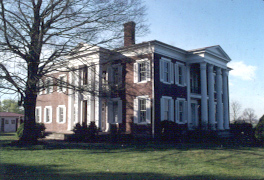
Maury County
The Tennessee General Assembly established Maury County on November 16, 1807. Taken from parts of Williamson and Dickson Counties, the new county was named for Abram Maury, a state senator from Williamson County.
Columbia, the county seat, was laid out and lots sold in 1808. At that time, the town consisted of four square blocks. In 1996 Columbia’s city limits stretched 15.5 miles from Spring Hill to Mt. Pleasant, towns that were settled at the same time as Columbia. Columbia was incorporated in 1817, Mt. Pleasant in 1824, and Spring Hill in 1901.
From the beginning the rich soil of Maury County attracted settlers, who planted cotton and tobacco and raised livestock. The Polk family plantations at Ashwood became regionally famous for their rich array of agricultural products. After the Civil War farmers shifted from cotton to grain and livestock raising; the Cleburne Jersey Farm near Spring Hill became nationally known for its dairy production and sold Jersey cattle to many other farms in the region. During these years, however, tobacco became the county’s largest cash crop. In the twentieth century progressive agricultural practices were demonstrated and made popular through programs at the Middle Tennessee Agricultural Experiment Station near Spring Hill. Today Maury County leads the state in the production of beef cattle and remains a major producer of corn, wheat, grain, sorghum, and cotton.
The county’s long history of agricultural success can be attributed, in part, to the richness of the Maury County soil with its underlying layer of phosphate rock, once the bottom of an ancient seabed. In 1888 William Shirley’s discovery of high grade brown phosphate rock at Mount Pleasant launched a mining industry that flourished for more than one hundred years. With the arrival of processing plants in the 1930s, Maury County moved from an agricultural to an industrial economy. Thousands of Maury Countians worked in the phosphate industry for such companies as Hooker, Monsanto, Occidental, and Stauffer until environmental concerns and dwindling resources forced its decline in the mid-1980s.
Phosphate made Mt. Pleasant a boomtown, but the arrival of the Saturn Corporation in the 1980s produced phenomenal growth at Spring Hill. The town grew almost 427 percent between 1990 and 2000, reaching a population of 7,715. With over 8,400 employees, Saturn is the largest employer in the county, followed by Maury Regional Hospital and the Maury County School System.
Maury County is serviced by a good rail system, an excellent trucking industry, the Maury County Airport, four radio stations, a daily newspaper, and a weekly newspaper. Columbia State Community College was the first community college in the state.
In recent years Maury County has emerged as an important tourist center. Except for the resort counties, Maury County annually welcomes a larger number of tourists than any other rural county in Tennessee. Visitors pour into Columbia for the annual Mule Day celebration in April. Throughout the year, tourists visit the large number of historical sites scattered throughout the county, including the James K. Polk Home, the Athenaeum, and Elm Springs in Columbia. Visitors to Spring Hill tour Rippavilla and Oaklawn, both of which figured in the Civil War fighting of November 1864. Civil War reenactments take place at Elm Springs and in the Spring Hill area.
Just inside the Mt. Pleasant city limits stands St. John’s Episcopal Church, one of the few remaining plantation churches in the country. Nearby is Rattle and Snap, built for George Polk in 1845; this National Historic Landmark is considered one of the great houses in North America. Across the highway is the first of the Polk family plantations, Hamilton Place. In downtown Mt. Pleasant, tourists visit the Mt. Pleasant/Maury Historical Phosphate Museum and the Mt. Pleasant Public Library, which features the “Bigby Grey Flag,” made in 1862 for local Confederate volunteers. The Maury County Chapter of APTA and the Maury County Convention and Visitors Bureau sponsor an annual tour of the many fine homes and sites in the county.
A number of Maury Countians have contributed to Tennessee and national history, including James K. Polk, governor of Tennessee, Speaker of the U.S. House of Representatives, and eleventh president of the United States. A. O. P. Nicholson served Tennessee as state representative, state senator, U.S. senator, and chief justice of the Supreme Court of Tennessee. William J. Harbison served as state chief justice for twenty years in the late twentieth century. Edward W. Carmack, Henry Cooper, and W. C. Whitthorne served in the U.S. Senate. Dr. Marion Dorsett discovered a method for producing a serum to prevent hog cholera. Lindsey Nelson was a famous radio and television announcer of football games for the University of Tennessee, the University of Notre Dame, and the CBS network.
Maury Countians have also made their mark in the military. Sons and daughters of Maury County have fought and died in every conflict from the War of 1812 to the Gulf War, contributing to the history of the state and nation. Fran McKee, a Maury County native, became the first female line admiral in the U.S. Navy. Captain Meade Frierson received the Distinguished Service Cross for action in World War I. Colonel Wibb Earl Cooper, who fought in World Wars I and II, received the Distinguished Service Cross with Oak Leaf Cluster for exceptional heroism in combat during World War II. John Harlan Willis was awarded posthumously the Congressional Medal of Honor for gallantry in action in World War II.
The county’s 2000 population stood at 69,498, an increase of 26.8 percent since 1990.



